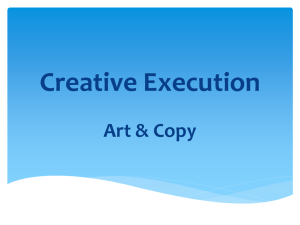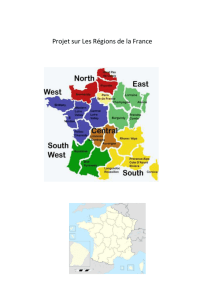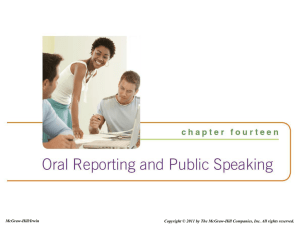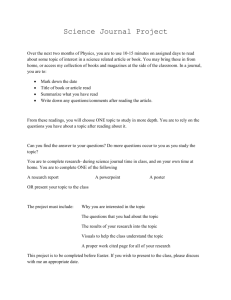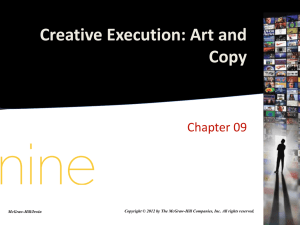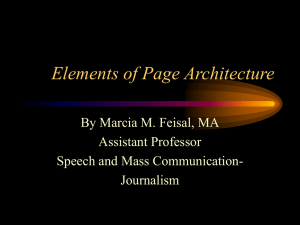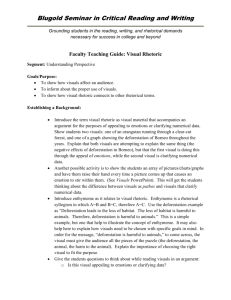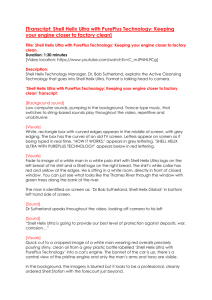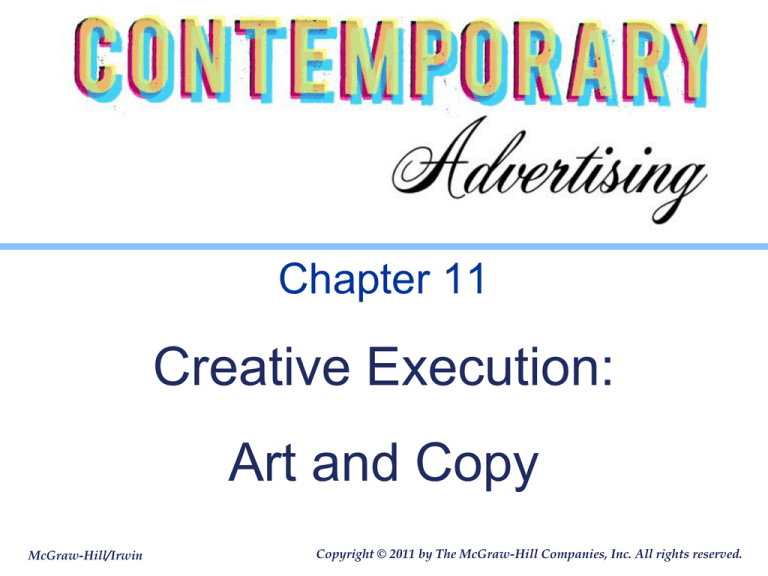
Chapter 11
Creative Execution:
Art and Copy
McGraw-Hill/Irwin
Copyright © 2011 by The McGraw-Hill Companies, Inc. All rights reserved.
Chapter Overview
The role of art and copy in
print, radio, and TV advertising
11-2
Chapter Objectives
Describe the roles of
artists in the ad business
Explain the role of the
copywriter
Explain ad layouts and
the steps to create them
Identify the art director’s
role in radio commercials
Outline the creative
approval process
Debate the pros and cons
of different types of TV
commercials
11-3
Delivering on the Big Idea
What is shown is just as important as what
is said… sometimes more
Positions the product
Creates brand personality
Sets the mood
Flavors the message (copy)
11-4
The Art of Creating Print Ads
Design
How the art director and graphic artist
choose and structure the artistic elements of the ad
Layout
How chosen ad format elements are arranged
Visuals, headline,
subheads, body copy, slogan,
seal, logo, signature
11-5
Art Design and Production
Thumbnail
Rough Layout
Comprehensive
Small, rapidly
produced drawing
for visualization
Drawn to actual
size, art sketched
in, body copy lines
Facsimile of the
finished ad
Mechanical
Dummy
Text and visuals
in exact position,
ready for camera
Presents look
and feel of
brochures
11-6
Creative and Approval Process
11-7
Principles of Design
Balance
Unity
Proportion
Emphasis
Sequence
Strong design . . .
commands attention
holds that attention
tells as much as possible
facilitates understanding
11-8
Commonly Used Software
Page Layout
QuarkXPress,
FrameMaker, InDesign
Painting / Drawing
CorelDRAW, Macromedia
Freehand, Adobe Illustrator
Image Manipulation
Adobe Photoshop,
Corel Paint Shop Pro
Web Design
Macromedia FLASH
Word Processing
Microsoft Word,
Corel WordPerfect
11-9
Which Layout Works Best?
Also called
poster-style. A
single, large
visual occupies
about twothirds of the ad
Picture Window
Vertical and
horizontal lines
and shapes in
a grid give
geometric
proportion
Mondrian Grid
11-10
Which Layout Works Best?
Filled with
multiple
illustrations,
oversized type,
reverse blocks,
etc. to bring
the ad alive
Circus
Copy
surrounded by
the visual, or
visual
surrounded by
copy
Picture Frame
11-11
Which Layout Works Best?
When you
have a lot to
say and visuals
won’t say it
Copy-Heavy
Similar to
circus. Uses
multiple
illustrations to
make a single
composition
Montage
11-12
Which Layout Works Best?
Combining two
or more
elements to
make an ad
more
interesting
Combo
11-13
Basic Design Rules
Balance
Proportion
Sequence
Unity
Emphasis
11-14
Use of Visuals
Purposes
Capture attention
Clarify copy
Identify subject
Show product in use
Qualify readers
Support truth of copy
Arouse interest in headline
Emphasize features
Create favorable impression
Provide campaign continuity
11-15
Use of Visuals: Poster Format
Higher Readership and Recall Scores
11-16
Use of Visuals
Chief Focus
Possibilities
Package
Product alone
Product in use
How to use product
Product features
Comparison of products
User benefit
Humor
Testimonial
Negative appeal
11-17
Use of Visuals
Ads with humor are more likely
to be remembered
11-18
Use of Visuals
Selecting the
Visual
Is a visual needed for communication?
Black-and-white or color?
Subject’s relevance to creative strategy?
Illustrator or photographer?
Technical or budgetary issues?
11-19
Print Ad Copy and Format
11-20
Headlines & Subheads
Type
Purpose
Benefit Attract attention
News/Information Engage audience
Provocative Explain visual
Question Lead into ad body
Command Present message
11-21
Headlines & Subheads
Subheads
Above or below head
Different color or style
Support “interest” step
11-22
Headlines & Subheads
A great headline can do a lot of
heavy lifting in a print ad
11-23
Body Copy
Styles
Formats
Straight-Sell
Lead-in paragraph
Institutional
Interior paragraphs
Narrative
Trial close
Dialogue/Monologue
Close (“action” step)
Picture Caption
Device
11-24
Slogans, Themelines, Taglines
“Breakfast of Champions”
“Reach out and touch someone”
“Diamonds are forever”
1
Provides continuity to a series of ads
2
Reduces an advertising message
strategy to a brief, repeatable,
memorable positioning statement
11-25
Seals, Logos, Signatures
Seal
Awarded when a product meets
established standards
Logos and
signature cuts
Special designs of the
advertiser’s company or
product name
11-26
Writing Radio Copy
Time Guidelines
Seconds Words
10
20-25
20
40-45
30
60-70
60
130-150
11-27
Writing Television Copy
Script
Same format as radio, but left
side is Video, right side is Audio
Video Column
Describes the visuals and
production
Audio Column
Lists the spoken copy, sound
effects, and music
11-28
Ad Formats
Execution
Spectrum,
developed by
Hank Seiden
11-29
Ad Formats
Straight Announcement
Musical
Presenter
Slice of Life
Testimonial
Lifestyle
Demonstration
Animation
11-30
Storyboards
After creatives finalize a TV
spot’s concepts . . .
artists develop storyboard
roughs . . .
including camera angles and
the script . . .
to provide a visual guideline
for production.
11-31
Writing for the Web
Audience: Burson-Marsteller’s e-fluentials
11 million heavy
Internet users
Share opinions
with many others
Verify ad claims
by visiting
company website
Reid-Goldsborough’s writing suggestions
Content, not
image, is king on
the Web
Site visitors scan
rather than read
Web users hate
hype and puffery
11-32
Ads for International Markets
Campaign Transferability Debate
Too expensive to create
a unique campaign
for every nation
or
Success requires creating
a unique campaign
for each market
Translating Copy
Translator must be an
effective copywriter
Translator must
understand the product
Translate from learned
language into native
language
Advertisers should provide
easy-to-translate copy
11-33
Ads for International Markets
Other Considerations
Use of color
Icon or visual image
Phrases or slogans
Legal restrictions
11-34

